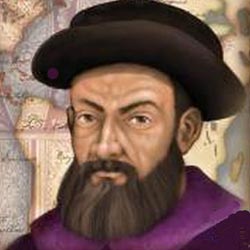This is one of astronomer Carl Sagan‘s most famous quotes: “We’re made of star stuff” (and one of my favorites, too).
This is one of astronomer Carl Sagan‘s most famous quotes: “We’re made of star stuff” (and one of my favorites, too).
Verona Rupes on Uranus‘ moon, Miranda, is estimated to be more than 12 miles deep – ten times the depth of the Earth’s Grand Canyon (which is slightly more than a mile deep).
Because of Miranda’s weak gravity, if a person jumped from this cliff, it would take 12 minutes before they hit the bottom. Sounds like a slow, gentle trip, right? Wrong. By the time they reached the bottom, they would be traveling at the speed of a race car – about 125 miles per hour!
This photo of Verona Rupes was captured by the passing Voyager 2 robotic spacecraft in 1986. How the giant cliff was created remains unknown, but is possibly related to a large impact by a meteor or other celestial body, or tectonic plate motion on Miranda’s surface.
Posted in Astronomy

Click on the illustration above to visit the National Geographic website, where you can see a short video about equinoxes.
In Northern California, Fall will officially begin at 8:09 this evening, with an astronomical event called an equinox. This equinox is special because it will also occur on the same night as a full moon. This is the first time these two things have happened together since 1991. Traditionally, the full moon closest to the September equinox is called the Harvest Moon.
An equinox occurs twice a year. The first day of Spring (which happens in March) is called the Vernal Equinox, and the first day of Fall (today) it is called the Autumnal Equinox. The first days of Summer and Winter are called solstices.
During an equinox, Earth’s axis points straight toward the sun. It doesn’t tilt away from, or toward, the sun. In this way, the center line of the sun is directly over the center line of the Earth, or the equator.
Because equinoxes happen when two round objects align – the Earth and our sun – they actually happen at different times around the globe. The time for an equinox is first calculated in Coordinated Universal Time (UTC) which is standardized for the entire Earth, based on atomic time and adjusted for the Earth’s rotation. However, you can use a seasons calculator to figure out exactly when the equinox is happening in different parts of the world.
Today, in the United States, many people won’t notice or celebrate the equinox. However, in ancient civilizations, astronomical events such as equinoxes and solstices were very important. Entire monuments were built to help people appreciate how big and special these celestial events are. In some cultures, these events are still celebrated. (Watch the National Geographic video to learn more)
 It was on September 20th in 1519 that Ferdinand Magellan set sail from Spain on the first successful attempt to sail all the way around the world. The word “circumnavigate” is used to describe this feat.
It was on September 20th in 1519 that Ferdinand Magellan set sail from Spain on the first successful attempt to sail all the way around the world. The word “circumnavigate” is used to describe this feat.
A native of Portugal, Magellan sailed under the Spanish flag with a fleet of five ships and 237 men.
As a result of his successful voyage, his name has come to represent exploration and navigation. NASA launched the Magellan spacecraft in May 1989, on an unmanned exploratory flight to Venus. It arrived at its destination in August of 1990, and for several years, it flew in an orbit around the planet. Cameras on board Magellan took pictures of Venus, enabling scientists to map 98 percent of the planet’s surface.
Scientists are particularly interested in Venus because they believe it to be the planet in the solar system most like our own, Earth.
The Magellan spacecraft’s mission ended with a dramatic flourish when scientists on Earth ordered it to crash-land on the planet’s surface. This allowed the spacecraft to gather data on the planet’s atmosphere on the way down.
Like the Magellan spacecraft, Ferdinand Magellan didn’t make it home, either. He was killed in a battle in the Philipines during his expedition. While he didn’t actually finish circumnavigating the globe, his fleet did. However, only 18 of the 237 men who originally started out on the voyage finished the trip. They arrived home in 1522.
Other things named after Magellan include the Magellanic Clouds, which are dwarf galaxies; the Magellanic Penguin, which he first observed and recorded during his voyage, and a GPS system.
Posted in Astronomy, Exploration, History